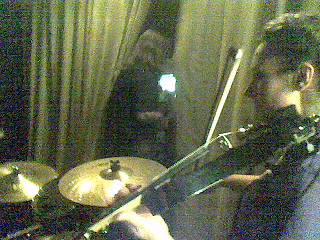I’ve recently joined a rock band, Helen’s Evil Twin and last night was my first gig with them. It was their highest profile show yet and one of the biggest pop music gigs that I’ve ever played. We were at the Wotever Extravaganza, part of the Royal Vauxhall Tavern‘s Hot August Fringe Festival.
The RVT used to be a music hall. This was a form of mass entertainment that predated things like radio and TV. The working classes would cram into cabaret theatres and watch people sing and play piano and dance, etc. So the club has a long bar on one wall and then the seating is arranged in a sort of semi-circular pattern, facing a small stage. Upstairs, there is a kitchen, an office, a large room holding many stage props and upstairs from that there are dressing rooms and a flat that somebody seems to live in.
Helen, the guitarist (every third British woman is named Helen), and I met early in the afternoon and loaded up her drum kit and two very tiny amplifiers into a hired car and took them to the RVT, but they ended up not being used, as the other band decided an hour beforehand to hire much better gear. In the UK, it seems to be very common that rock acts will share drum kits and amps at shows, whereas, in the States, every band seems to bring their own gear.
The show started at six with some poets and then DJ + dancing and then some cabaret acts and then DJ + dancing. Some of the acts were quite compelling. Two highlights were Jet Moon doing her bit about “Femme Packing,” which is fun. And Michael Twaits did part of his show, Icons and a piece about the Stonewall Riots, which I’ve seen him do about three times now and I get a lump in my throat every time, because it is so very excellent.
I went up to our dressing room to get changed. Taylor, the violinist came up and reported that there was a naked man on stage, speaking like the characters from The Sims, and smearing himself with paint. We tuned our instruments and when we heard echos of Ingo’s voice booming from below, we walked down to have a very brief tech check while another DJ was spinning tunes and a few people danced.

We hadn’t had a sound check, so the tech was asking questions and running cables. It was very suboptimal, but half the band hadn’t been able to show up until after the event started and it probably didn’t make sense to check with only bass and guitar. So we waited around back stage and I tried not to be overly nervous. Hoops, the drummer, said, “this is so exciting! It’s like being back stage before a gig!”

The club was packed, but Wotever audiences are very friendly. I was just concerned about making mistakes, as I’m new and all the songs had completely left my head. I had written out the chords next to song titles on my set list, so if the basslines completely escaped me, at least I could play the right roots.
Ingo came out and announced as and mentioned that I was the new bassist and people cheered. The stage lights were very bright, so I couldn’t really see people, except for one guy close to the front who seemed to fancy me. We started playing through our set and I wasn’t screwing up as much as I feared, so that was ok. And people were cheering and dancing in the front. When Helen said we were nearly done, a large number of people yelled “more” at us. We were like fucking rock stars!
I went upstairs and changed back into my street clothes and then watched the next band, The Blow Waves, who describe themselves as “the campest band in the world.” They were very fun.
Post Mortem
I need to be less nervous and have more stage presence. Also, I need to wear earplugs, as my ears were ringing like mad after wards. Sound checks are almost always a good thing. I think, in general, we should stand farther forward, take up more space, and own the stage more, because we could totally be rock stars. Or at least, I totally want to be a rock star, which is almost the same thing. With screaming fans, dancing people and dressing rooms!
I’m thinking I might want to write a few songs about pop music topics: love, sex and death. And by sex, I mean gender, of course.
Our next gig is in the West Midlands at Worchester Pride, on 22 August at the Mars Bar.
